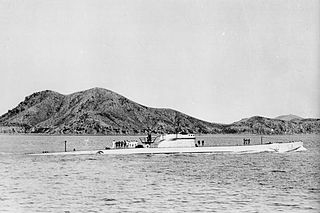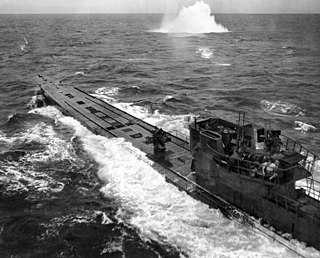
The Laconia incident was a series of events surrounding the sinking of a British passenger ship in the Atlantic Ocean on 12 September 1942, during World War II, and a subsequent aerial attack on German and Italian submarines involved in rescue attempts. RMS Laconia, carrying 2,732 crew, passengers, soldiers, and prisoners of war, was torpedoed and sunk by U-156, a German U-boat, off the West African coast. Operating partly under the dictates of the old prize rules, the U-boat's commander, Korvettenkapitän Werner Hartenstein, immediately commenced rescue operations. U-156 broadcast her position on open radio channels to all Allied powers nearby, and was joined by the crews of several other U-boats in the vicinity.
German submarine U-429 was a Type VIIC U-boat of Nazi Germany's Kriegsmarine originally built for the Italian Regia Marina during World War II. Her keel was laid down on 14 September 1942 by Danziger Werft of Danzig. She was then commissioned as S-4 on 14 July 1943 under the command of Tenente di vascello Angelo Amendolia.

The Regia Marina (RM) or Royal Italian Navy was the navy of the Kingdom of Italy from 1861 to 1946. In 1946, with the birth of the Italian Republic, the Regia Marina changed its name to Marina Militare.
Foreign U-boats was the title for a special section created by Nazi Germany's Kriegsmarine that adopted 13 captured enemy submarines and a single Turkish vessel into the U-boat corps. Beginning in 1939 and lasting until the end of World War II in 1945, the Kriegsmarine modified a total of 13 captured enemy submarines, then deployed them into combat with German crews. The special corps was not especially successful, as only ten enemy ships were destroyed by Foreign U-boats through the entire war. Eight of these were destroyed by UA, which was a modified Type IX U-boat originally built for the Turkish Navy. However, some were effective as minelayers.

German submarine U-511 was a Type IXC U-boat of Nazi Germany's Kriegsmarine during World War II. The submarine was laid down on 21 February 1941 at the Deutsche Werft yard in Hamburg as yard number 307, launched on 22 September 1941 and commissioned on 8 December 1941 under the command of Kapitänleutnant Friedrich Steinhoff.

Barbarigo was a World War II Italian Marcello-class submarine. It was built by the Cantieri Riuniti dell'Adriatico, and was commissioned on 19 September 1938.

The Marcello class was a class of nine submarines built in 1937 and 1938 by CRDA in Trieste for the Royal Italian Navy. Two similar submarines built in 1939 at La Spezia by Oto Melara are sometimes considered part of the class. All eleven served in the Mediterranean Sea at the start of the Second World War. After Provana's 1940 sinking, the remaining boats were transferred to the BETASOM Atlantic submarine base at Bordeaux in August 1940. After four boats had been sunk in the Atlantic, Barbarigo and Comandante Cappellini were then selected for conversion to "transport submarines" in order to exchange rare or irreplaceable trade goods with Japan. Cargo capacity of 160 tons reduced reserve buoyancy from 20–25% to 3.5–6%; and armament was reduced to defensive machine guns. Only Dandolo was in operational condition at the end of the war.

The Gruppe Monsun or Monsoon Group was a force of German U-boats (submarines) that operated in the Pacific and Indian Oceans during World War II. Although similar naming conventions were used for temporary groupings of submarines in the Atlantic, the longer duration of Indian Ocean patrols caused the name to be permanently associated with the relatively small number of U-boats operating out of Penang. After 1944, the U-boats of the Monsun Gruppe were operationally placed under the authority of the Southeast Asia U-boat Region.

The U-27 class was a class of eight submarines or U-boats built for and operated by the Austro-Hungarian Navy during World War I. The class was based upon the German Type UB II design of the German Imperial Navy and was constructed under license in Austria-Hungary.

Nereide was a Nautilus-class submarine in the Italian Royal Navy during World War I. She was built 1911–1913 at the navy yard at Venice and was sunk in 1915 by the Austro-Hungarian submarine U-5 under the command of Georg Ritter von Trapp. Nereide's captain, Carlo del Greco posthumously received the Medaglia d'Oro al Valore Militare for his actions when Nereide was sunk.

Salvatore Pelosi was an Italian naval officer who fought in World War II. As commander of the submarine Torricelli he made a gallant last stand against overwhelming British naval forces in June 1940.
SM U-50 was one of 329 submarines in the Imperial German Navy in World War I. She took part in the First Battle of the Atlantic.

The Type UE II submarines were a class of submarines built by the German Empire during World War I as long-range mine-layers.
Italian submarine Luigi Torelli was a Marconi-class submarine of the Italian navy during World War II. The vessel operated in the Atlantic from September 1940 until mid-1943, then was sent to the Far East. After Italy's surrender in 1943, the Luigi Torelli was taken over by Nazi Germany's Kriegsmarine, then, in the waning months of the war, the Japanese Imperial Navy. It was one of only two ships to serve in all three major Axis navies, the other being the Italian submarine Comandante Cappellini.
German submarine U-750 was a German Type VIIC submarine U-boat built for Nazi Germany's Kriegsmarine for service during World War II.

German submarine U-428 was a Type VIIC U-boat of Nazi Germany's Kriegsmarine during World War II.
German submarine U-430 was a Type VIIC U-boat of Nazi Germany's Kriegsmarine during World War II.
German submarine U-746 was a Type VIIC U-boat of Nazi Germany's Kriegsmarine built for service during World War II. Her keel was laid down on 15 July 1942 by Schichau-Werke of Danzig. She was commissioned on 4 July 1943 with Tenente di vascello Augusto Biagini in command.

German submarine U-1161 was a Type VIIC U-boat of Nazi Germany's Kriegsmarine during World War II.
Alfredo Cappellini or Comandante Cappellini was the name of at least three ships of the Italian Navy named in honour of Alfredo Cappellini and may refer to:












